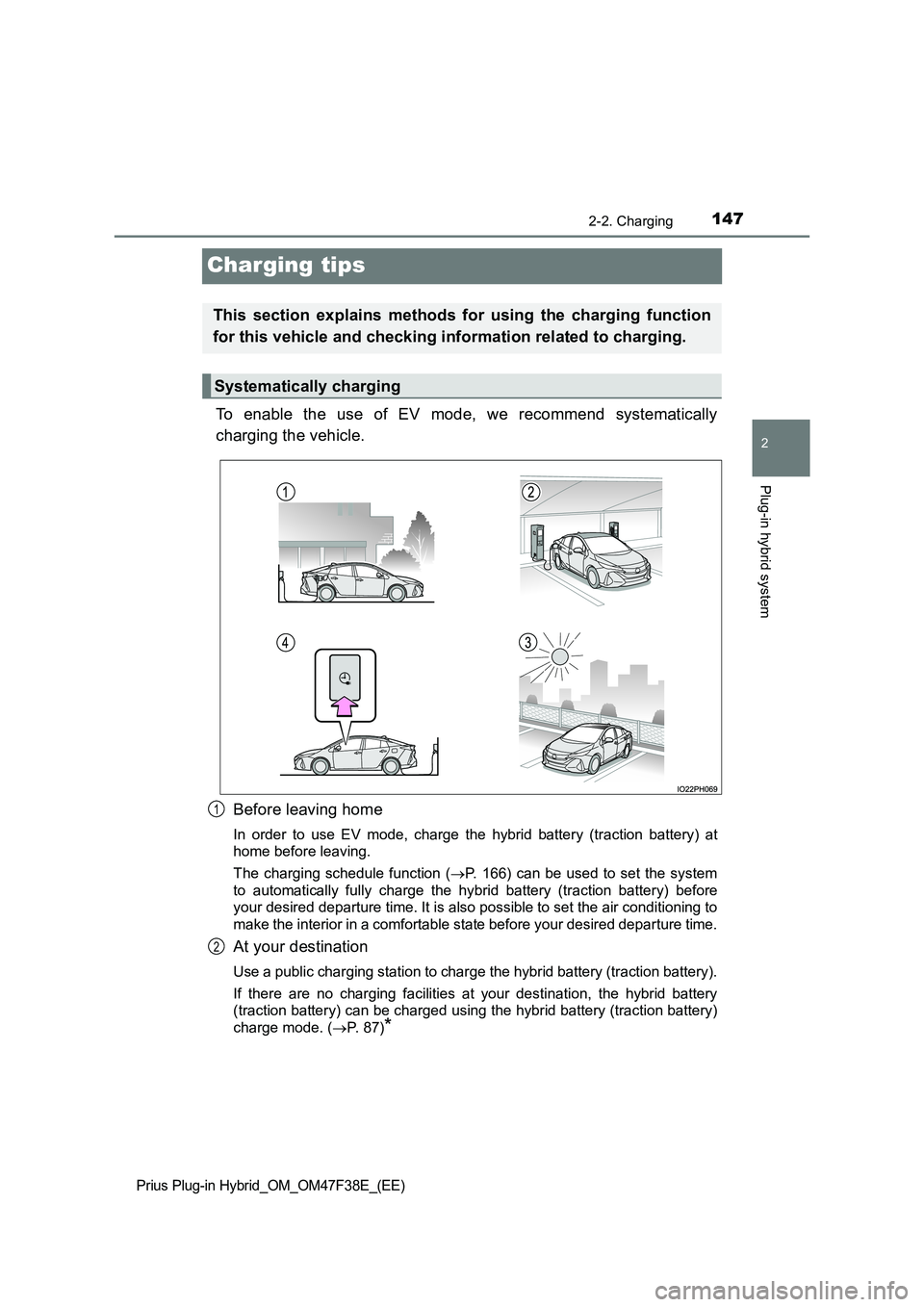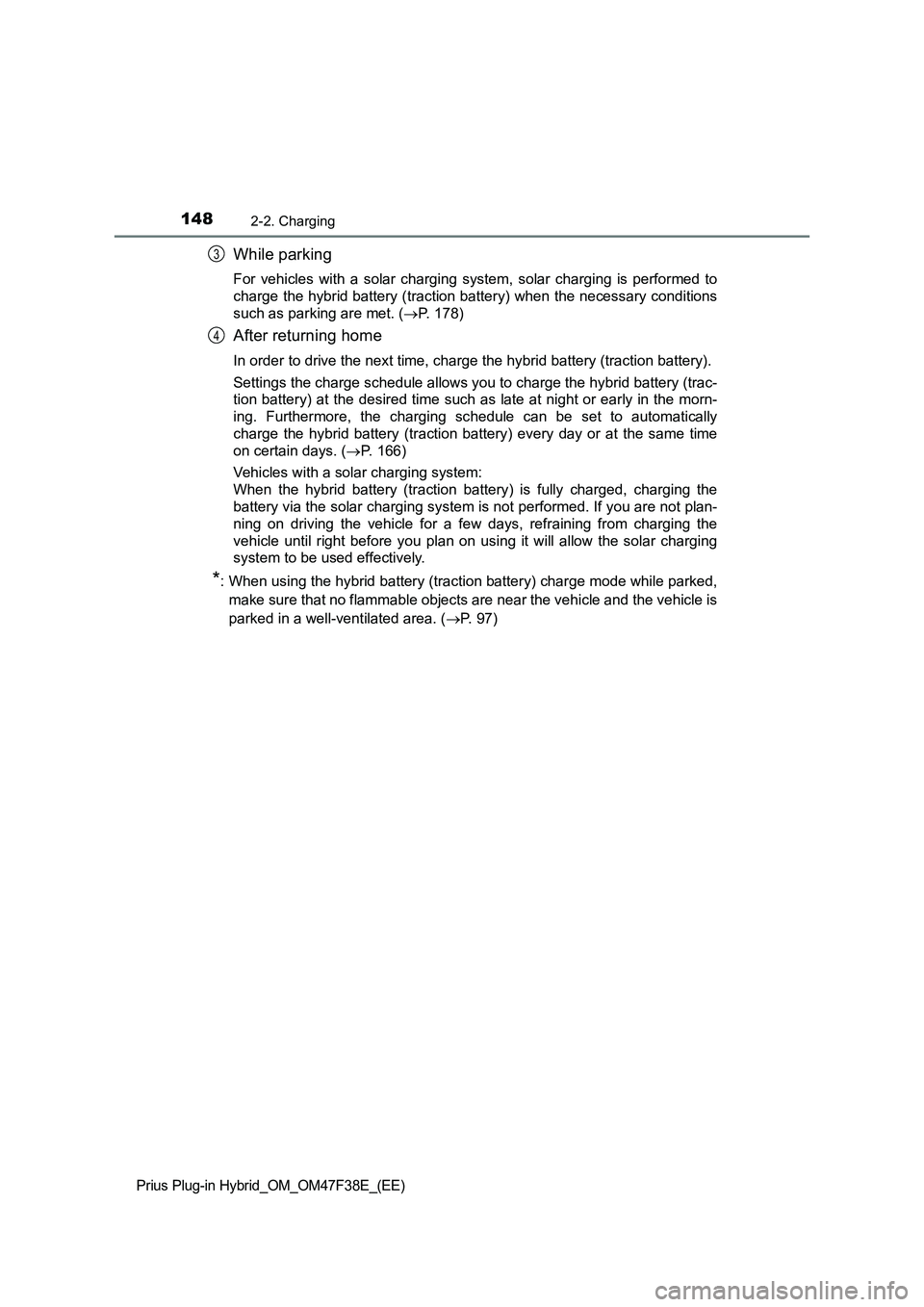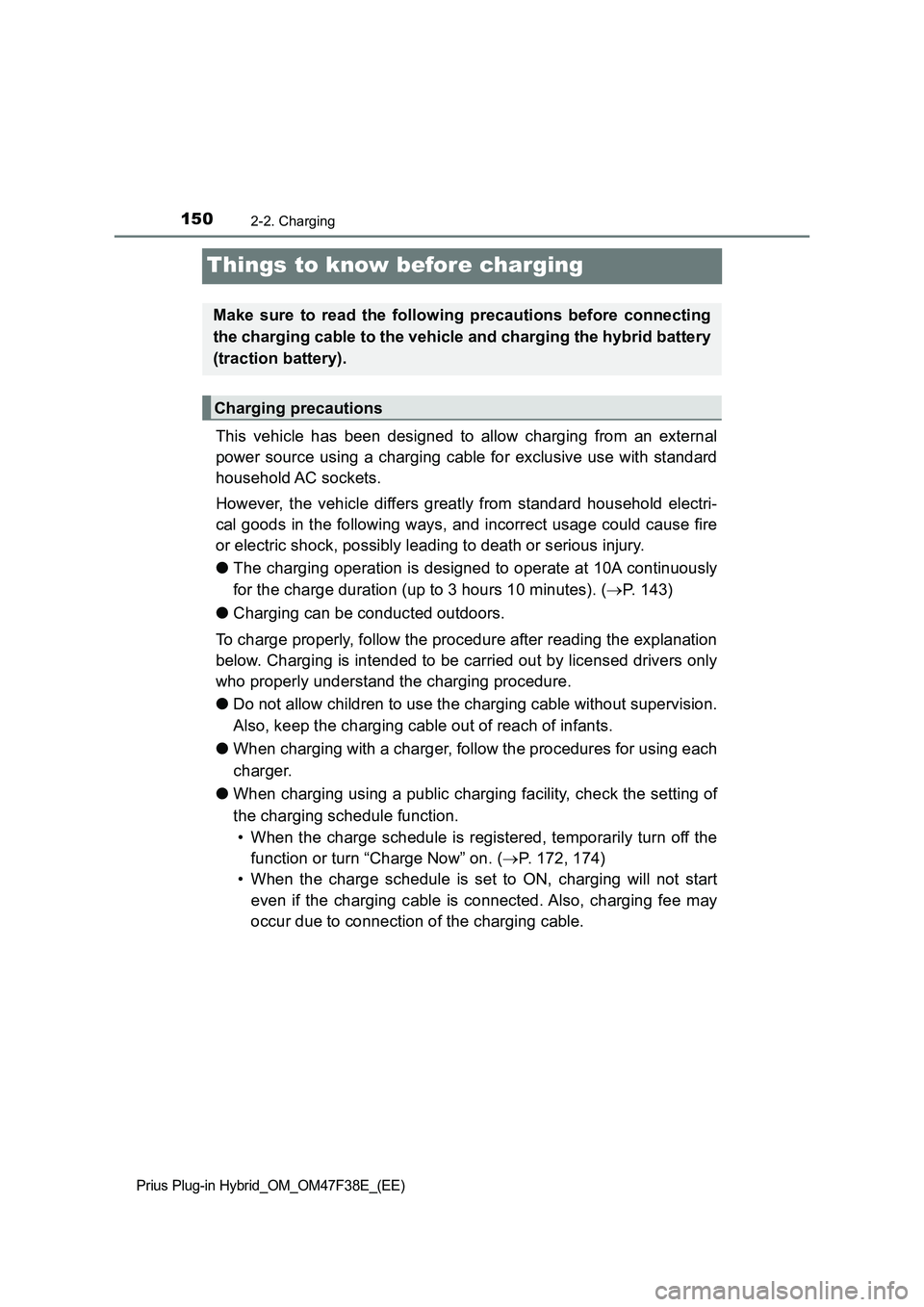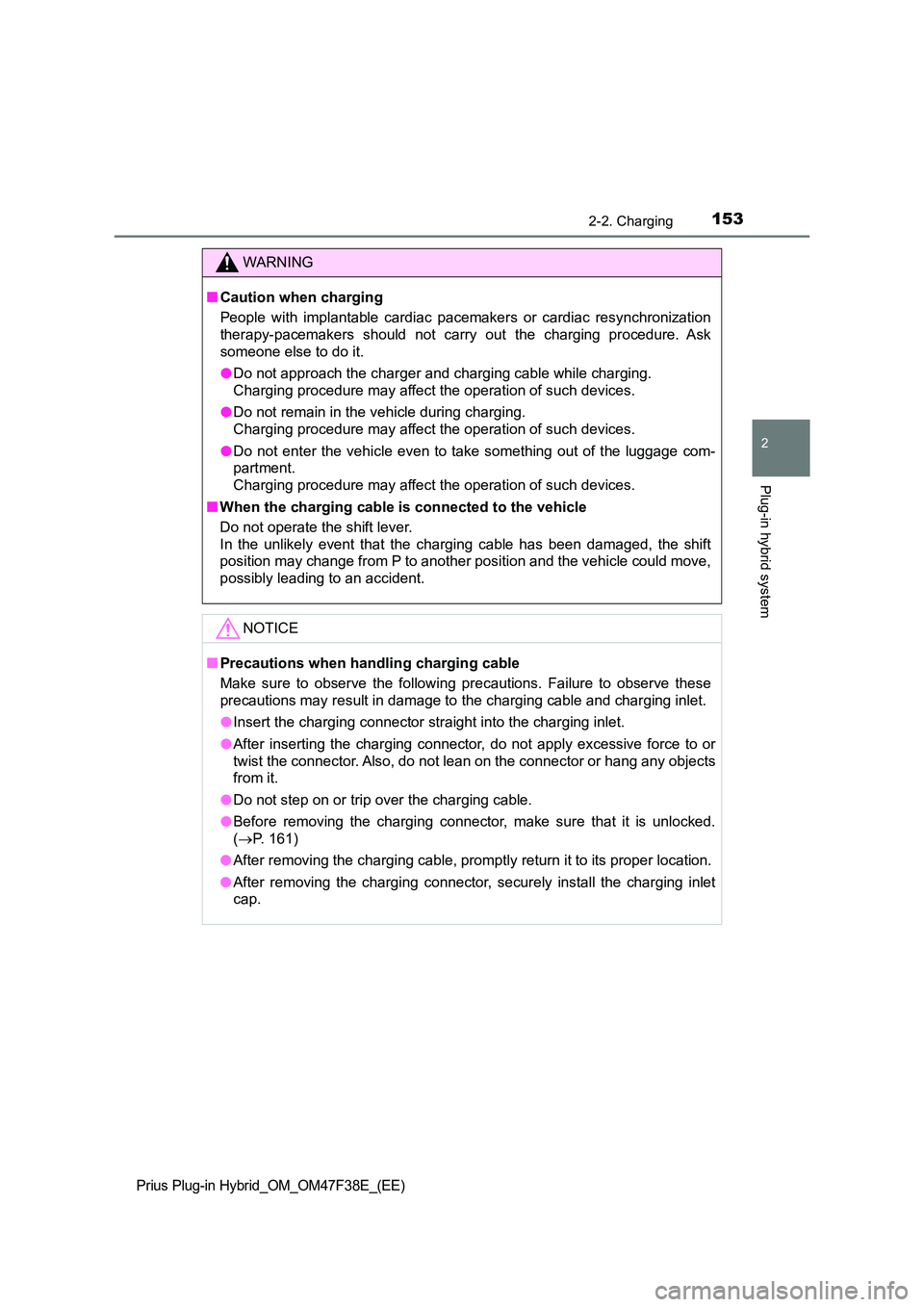2023 TOYOTA PRIUS PLUG-IN HYBRID charging
[x] Cancel search: chargingPage 148 of 818

1462-2. Charging
Prius Plug-in Hybrid_OM_OM47F38E_(EE)
■“Traction Battery Cooler” (if equipped)
●When the hybrid battery (traction battery) is above a certain temperature
and the power switch is turned off, a check screen is displayed on the multi-
information display that indicates whether “Traction Battery Cooler” is imple-
mented. Approximately 5 minutes after selecting “Yes” on this screen, sys-
tem operation becomes possible.
●When charging starts, “Traction Battery Cooler” only operates if the hybrid
battery (traction battery) temperature is hot.
●The charging indicator is illuminated while “Traction Battery Cooler” is on
standby or operating.
●“Traction Battery Cooler” is implemented for a maximum of approximately
30 minutes. However, when the “Departure” time is set (P. 166) and there
is not sufficient time between the current time and the time that charging will
complete, “Traction Battery Cooler” operation time may become shorter.
●When there is a small amount of remaining charge in the hybrid battery
(traction battery), even if the hybrid battery (traction battery) is hot, “Traction
Battery Cooler” may not be implemented.
●When the following operations are performed while “Traction Battery Cooler”
is operating, the hybrid battery (traction battery) cooling operation stops.
• A door is opened
• The hood is opened
• The power switch is turned to any mode other than off
• The alarm operates (if equipped) (P. 7 6 )
• The shift position is changed to any position other than P
• The Remote Air Conditioning System is operated (P. 535)
• “Charge Now” is implemented (P. 167)
• The amount of remaining charge in the hybrid battery (traction battery) is
below a certain amount
●When the power switch is turned off, a check screen is displayed on the
multi-information display that indicates whether “Traction Battery Cooler” is
implemented. This check screen can be turned on and off in the “Meter Cus-
tomize” settings on the multi-information display (P. 250). However, when
the check screen is set to “Off”, “Traction Battery Cooler” is no longer oper-
ates.
●“Traction Battery Cooler” uses the power of the hybrid battery (traction bat-
tery) and external power source.
• While “Traction Battery Cooler” is operating, the amount of the remaining
charge of the hybrid battery (traction battery) increases and decreases in
a certain range, and does not increase as in normal charging.
• The operation of “Traction Battery Cooler” is recognized as charging by a
charger. The charger that calculates the fee according to charging time
causes a charging fee.
Page 149 of 818

147
2
2-2. Charging
Plug-in hybrid system
Prius Plug-in Hybrid_OM_OM47F38E_(EE)
Charging tips
To enable the use of EV mode, we recommend systematically
charging the vehicle.
Before leaving home
In order to use EV mode, charge the hybrid battery (traction battery) at
home before leaving.
The charging schedule function ( P. 166) can be used to set the system
to automatically fully charge the hybrid battery (traction battery) before
your desired departure time. It is also possible to set the air conditioning to
make the interior in a comfortable state before your desired departure time.
At your destination
Use a public charging station to charge the hybrid battery (traction battery).
If there are no charging facilities at your destination, the hybrid battery
(traction battery) can be charged using the hybrid battery (traction battery)
charge mode. ( P. 8 7 )*
This section explains methods for using the charging function
for this vehicle and checking information related to charging.
Systematically charging
1
2
Page 150 of 818

1482-2. Charging
Prius Plug-in Hybrid_OM_OM47F38E_(EE)
While parking
For vehicles with a solar charging system, solar charging is performed to
charge the hybrid battery (traction battery) when the necessary conditions
such as parking are met. (P. 178)
After returning home
In order to drive the next time, charge the hybrid battery (traction battery).
Settings the charge schedule allows you to charge the hybrid battery (trac-
tion battery) at the desired time such as late at night or early in the morn-
ing. Furthermore, the charging schedule can be set to automatically
charge the hybrid battery (traction battery) every day or at the same time
on certain days. (P. 166)
Vehicles with a solar charging system:
When the hybrid battery (traction battery) is fully charged, charging the
battery via the solar charging system is not performed. If you are not plan-
ning on driving the vehicle for a few days, refraining from charging the
vehicle until right before you plan on using it will allow the solar charging
system to be used effectively.
*: When using the hybrid battery (traction battery) charge mode while parked,
make sure that no flammable objects are near the vehicle and the vehicle is
parked in a well-ventilated area. (P. 97)
3
4
Page 151 of 818

1492-2. Charging
2
Plug-in hybrid system
Prius Plug-in Hybrid_OM_OM47F38E_(EE)
Information related to charging can be displayed and checked on the
multi-information display.
■While charging
When any door is opened
during charging, the current
charging condition and remain-
ing time until charging is com-
plete can be checked.
■After charging is complete
After charging is complete, the
first time that the hybrid system
is started, a message detailing
the results of the charging is
displayed. Also, a message is
displayed if an operation that
stops charging is performed or
a situation where charging can-
not be performed occurs.
When a message is displayed, follow the instructions displayed on the
screen. (P. 187)
■Combination meter display during charging
If approximately 100 seconds elapse after the power switch is turned to ON
mode during charging, the power switch will automatically turn off and the dis-
play will disappear.
Checking information related to charging
Page 152 of 818

1502-2. Charging
Prius Plug-in Hybrid_OM_OM47F38E_(EE)
Things to know before charging
This vehicle has been designed to allow charging from an external
power source using a charging cable for exclusive use with standard
household AC sockets.
However, the vehicle differs greatly from standard household electri-
cal goods in the following ways, and incorrect usage could cause fire
or electric shock, possibly leading to death or serious injury.
●The charging operation is designed to operate at 10A continuously
for the charge duration (up to 3 hours 10 minutes). (P. 143)
●Charging can be conducted outdoors.
To charge properly, follow the procedure after reading the explanation
below. Charging is intended to be carried out by licensed drivers only
who properly understand the charging procedure.
●Do not allow children to use the charging cable without supervision.
Also, keep the charging cable out of reach of infants.
●When charging with a charger, follow the procedures for using each
charger.
●When charging using a public charging facility, check the setting of
the charging schedule function.
• When the charge schedule is registered, temporarily turn off the
function or turn “Charge Now” on. (P. 172, 174)
• When the charge schedule is set to ON, charging will not start
even if the charging cable is connected. Also, charging fee may
occur due to connection of the charging cable.
Make sure to read the following precautions before connecting
the charging cable to the vehicle and charging the hybrid battery
(traction battery).
Charging precautions
Page 153 of 818

1512-2. Charging
2
Plug-in hybrid system
Prius Plug-in Hybrid_OM_OM47F38E_(EE)
Before charging, always check the following items.
●The parking brake is applied. (P. 336)
●The headlights are switched off or set to AUTO, and lights such as
the emergency flashers and interior lights etc. are switched off.
If these light switches are turned ON, then these features will consume
electricity, and charging time will increase.
●The power switch is off. (P. 323)
Before charging, make sure that each part of the charging cable is in
good condition. (P. 126)
■Safety functions
●The hybrid system will not start while the charging cable is attached to the
vehicle, even if the power switch is operated.
●If the charging cable is connected while the “READY” indicator is illumi-
nated, the hybrid system will stop automatically and driving will not be possi-
ble.
●When the charging cable is connected to the vehicle, the shift position can-
not be changed from P to another position.
■During charging
The followings occur, however, it does not indicate a malfunction.
●The charging starting time may differ depending on the state of the vehicle.
●During charging, the sound of the fan may be heard from the onboard trac-
tion battery charger cooling air intake vents. (P. 154)
●During and after charging, the rear seat and its surrounding area in which
the onboard traction battery charger is installed may get warm.
Confirm the following before charging
Inspecting the charging cable
Page 154 of 818

1522-2. Charging
Prius Plug-in Hybrid_OM_OM47F38E_(EE)
■Capacity reduction of the hybrid battery (traction battery)
The capacity of the hybrid battery (traction battery) will decline gradually
when the hybrid battery (traction battery) is in use. The rate at which it
declines will differ in accordance with environmental conditions and the way
in which the vehicle is used. Observing the following can help suppress bat-
tery capacity decline.
●Avoid parking the vehicle in areas with a high temperature under direct sun-
light when the hybrid battery (traction battery) is fully charged.
●Avoid accelerating and decelerating frequently and suddenly when EV driv-
ing.
●Avoid frequent driving near the top speed for EV driving. (P. 9 4 )
●Leave a low level of charge in the hybrid battery (traction battery) when
leaving the vehicle undriven for a long period of time.
After confirming that EV mode has switched to HV mode, turn the power
switch off.
●Use the charging schedule function as much as possible in order to fully
charge the hybrid battery (traction battery) immediately before starting off.
(P. 166)
Also, if the hybrid battery (traction battery) capacity reduces, the distance that
can be driven in EV mode decreases. However, vehicle performance does
not significantly become worse.
■When the remaining charge of the hybrid battery (traction battery) is low
after charging
In the following situations, the remaining charge of the hybrid battery (traction
battery) after charging completes may be less than normal in order to protect
the system (the EV driving range after the battery is fully charged may be
shorter).
*
●Charging is carried out when the outside temperature is low or high
●Charging is carried out immediately after high-load driving or in extreme
heat
When none of the above situations apply and there is a drastic drop in the
remaining charge of the hybrid battery (traction battery) after charging com-
pletes, have the vehicle inspected by any authorized Toyota retailer or Toyota
authorized repairer, or any reliable repairer.
*: When this occurs, even if the remaining charge display of the hybrid battery
(traction battery) shows that it is fully charged, the remaining charge rapidly
decreases faster than normal.
■When the charging amount sent to the hybrid battery (traction battery)
decreases
When the amount of power supplied by the charger is low or operation of the
“Traction Battery Heater”, etc., reduces the charging power sent to the hybrid
battery (traction battery), the charging amount sent to the hybrid battery (trac-
tion battery) may decrease.
Page 155 of 818

1532-2. Charging
2
Plug-in hybrid system
Prius Plug-in Hybrid_OM_OM47F38E_(EE)
WARNING
■Caution when charging
People with implantable cardiac pacemakers or cardiac resynchronization
therapy-pacemakers should not carry out the charging procedure. Ask
someone else to do it.
● Do not approach the charger and charging cable while charging.
Charging procedure may affect the operation of such devices.
● Do not remain in the vehicle during charging.
Charging procedure may affect the operation of such devices.
● Do not enter the vehicle even to take something out of the luggage com-
partment.
Charging procedure may affect the operation of such devices.
■ When the charging cable is connected to the vehicle
Do not operate the shift lever.
In the unlikely event that the charging cable has been damaged, the shift
position may change from P to another position and the vehicle could move,
possibly leading to an accident.
NOTICE
■ Precautions when handling charging cable
Make sure to observe the following precautions. Failure to observe these
precautions may result in damage to the charging cable and charging inlet.
● Insert the charging connector straight into the charging inlet.
● After inserting the charging connector, do not apply excessive force to or
twist the connector. Also, do not lean on the connector or hang any objects
from it.
● Do not step on or trip over the charging cable.
● Before removing the charging connector, make sure that it is unlocked.
( P. 161)
● After removing the charging cable, promptly return it to its proper location.
● After removing the charging connector, securely install the charging inlet
cap.